Lee Chapel and Museum
Introduction
Text-to-speech Audio
Images
The Lee Chapel
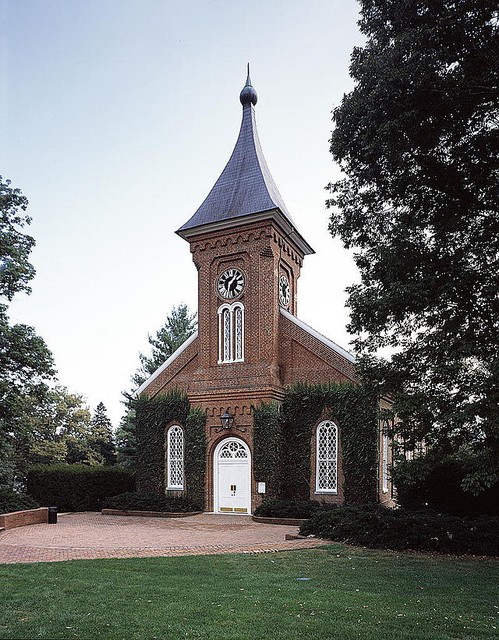
The "recumbent statue" of Robert E. Lee lying asleep on the battlefield - sculpted by Edward V. Valentine
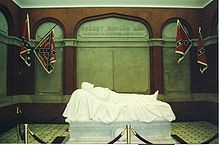
Recumbent Statue of Robert E. Lee, ca. 1929-1930
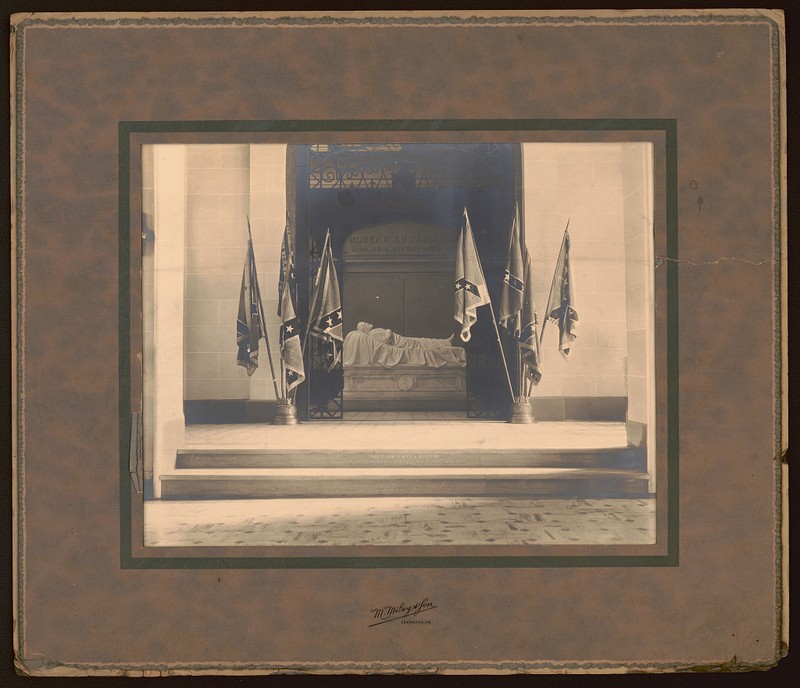
Interior - Looking towards the statue (southeast) from the balcony, Jul 1968
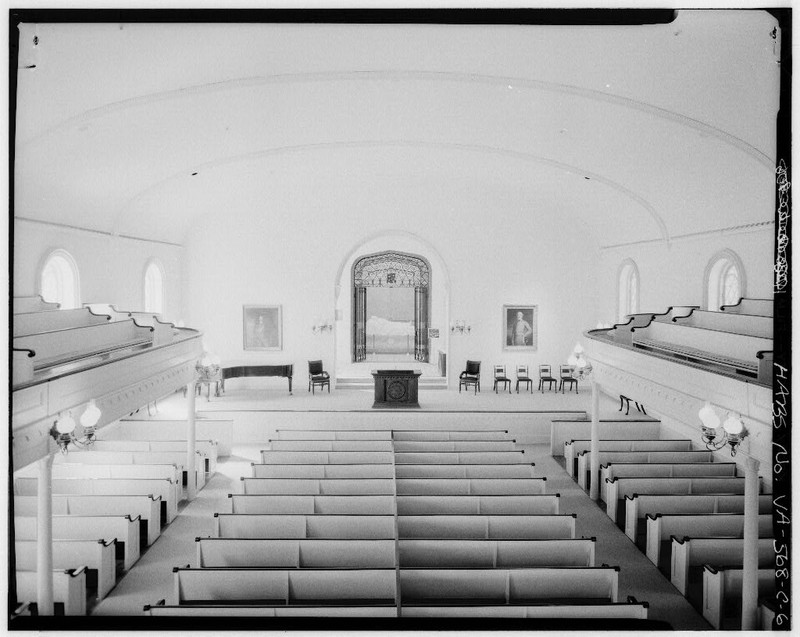
Looking down on the auditorium from the balcony, Jul 1968
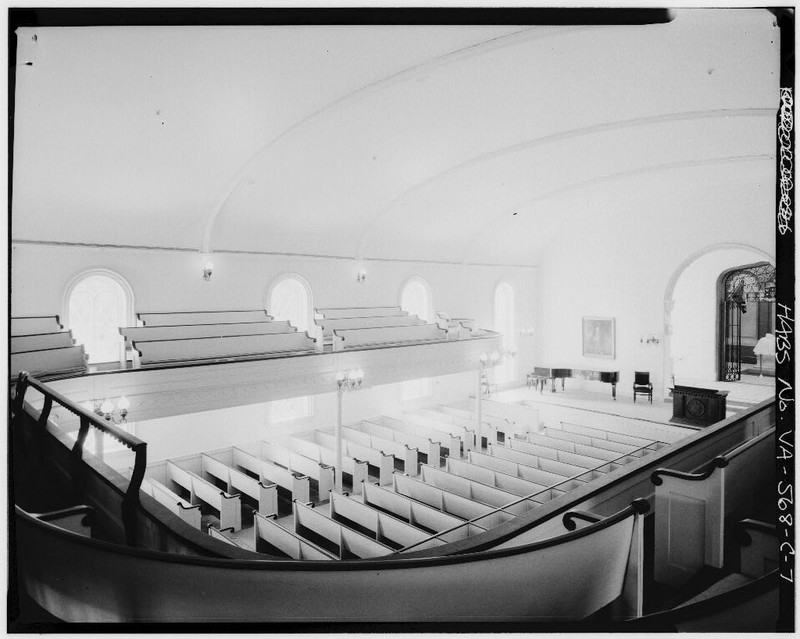
Looking into the auditorium (northwest) from the statue , Jul 1968
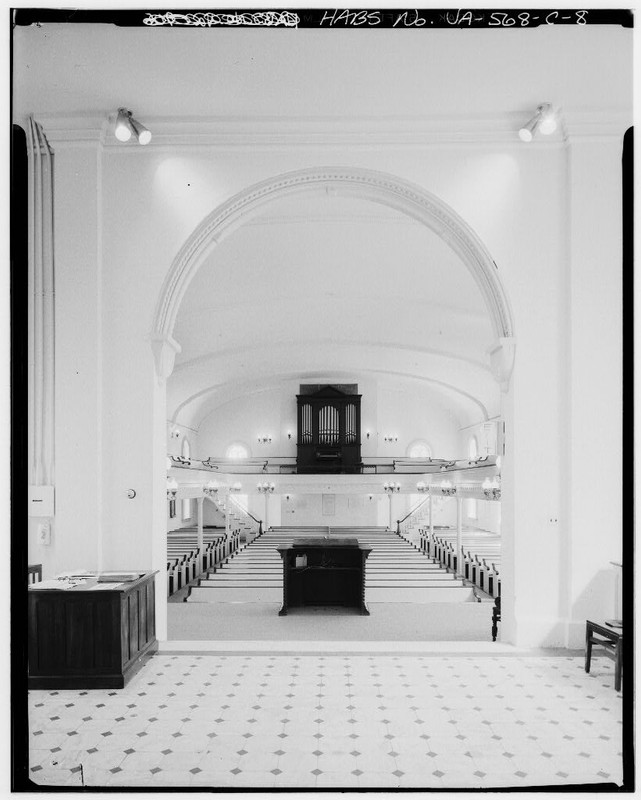
Backstory and Context
Text-to-speech Audio
Just over five months after his surrender at Appomattox, in September 1865, Robert E. Lee took up the position of president at what was then Washington College. It was struggling financially and could barely afford to pay Lee. However, using his contacts and leadership ability, he turned the failing college into a large, up-to-date university – “[u]nder his inspiring leadership, the enrollment increased sharply, the curriculum was constantly expanded, and the physical plant was greatly improved.”[16] This period has been called the “noblest phase” of Lee’s life.[16]
In 1866, as one of his first actions as president, Lee recommended construction of a new, larger chapel that could seat the entire student body. Approved in July, its Victorian-Gothic design was created by Thomas Williamson, engineering professor at VMI, with probable aid from Lee and his son, George Washington Custis Lee (also a VMI engineering professor). It was completed in 1868 and dedicated just before commencement exercises were conducted in it on June 14. Lee called it a, “pleasing as well as useful addition to the College buildings.”[7] In fact, he made daily use of it himself, attending worship services inside with the students before going downstairs to his office. (The downstairs also contained the treasurer’s office and YMCA student center.) His last day in this office was September 28, 1870, when he took ill, dying on October 12. His wife elected to bury him in a vault under the chapel, and his body was moved inside on October 14 and watched by a VMI honor guard until a funeral the next day. In remembrance of his transformative presidency, his office was kept as he left it and the school was renamed Washington and Lee University.
The Lee Memorial Association was organized shortly after his passing and began planning a permanent tribute to the general. They commissioned Edward Valentine to sculpt a statue of Lee in 1871 and it was delivered to the University in 1875. However, due to financial difficulties, there was no place to display it until 1883, when an addition to the back of the chapel was completed. This addition had an apse for the statue on the top floor and a burial crypt on the bottom floor, where Lee’s remains were moved. The addition and statue were dedicated on June 28, 1883, by Stonewall Jackson’s daughter in a ceremony attended by eight to ten thousand people. Lee’s father (“Light Horse Harry”) and mother, his wife, his seven children, and several of their descendants have since been interred in the crypt.
The University has since used the chapel for University-wide events and lectures, including the Honor Code Orientation and the Honor Book (also known as the White Book) signing ceremony. It was nearly torn down to make space for a larger chapel (that would also mesh architecturally with the University’s surrounding Greek Revival buildings) in the 1920s, but was saved by the United Daughters of the Confederacy, which also built the museum in the lower story in 1928. The chapel was remodeled in the early 1960s and restored in the late 1990s. In 2007, a new, permanent exhibit, entitled “Not Unmindful of the Future: Building and Rebuilding a Nation,” was opened in the museum. (There is also a museum shop and a temporary exhibit space.)
In 2014, a petition was signed requesting, among other things, removal of replica Confederate flags (not part of the 1883 design) located in the apse of the chapel. This request was complied with, and an agreement was signed allowing original battle flags that had been loaned or donated to the University (but since removed due to preservation concerns) to be displayed in the museum on rotation.
In 2017, after the death of counter-protester Heather Heyer during the "Unite the Right" rally in Charlottesville, Virginia, the University President, William Dudley, created a Commission on Institutional History and Community. Their final recommendations regarding the chapel included moving all events elsewhere, turning it into the “University Museum," and referring to Lee only as “President,” not “General”. The President agreed to close the doors to the apse during university functions and exchange military portraits of both Washington and Lee for civilian paintings to make sure “that university events do not feel as though they take place in a Confederate shrine.”[6] However, he refused to move events from Lee Chapel and effectively eliminate it from campus life and tradition, arguing that it held an important, irreplaceable spot in the University’s heritage.
The debate over the Chapel’s history, future, and purpose has continued. Its National Register of Historic Places nomination says that, “[m]ore than a repository of [Lee’s] mortal remains, it is a monument to his unceasing efforts to erase the bitter feelings engendered by the Civil War, and to provide proper training for the youth of the South.”[16] However, as University President Cole noted, the chapel’s use has shifted from its original purpose of a place of worship and home of university gatherings to become a museum, burial ground, and what has been called, “The Shrine of the South.”[17] President Dudley remarked that, “Lee almost certainly would have opposed…these developments. His personal modesty would have generated strong resistance to making himself the focal point of the chapel. And he expressly argued against the creation of Civil War memorials, rightly believing they would perpetuate division and impede national reconciliation and prosperity.”[6] The University continues to use the chapel, saying that this allows critical-thinking-based consideration of its heritage and of the legacies of George Washington and Robert E. Lee.
Cite This Entry
Woodard, Benjamin and Cayla Monroe. "Lee Chapel and Museum ." Clio: Your Guide to History. August 17, 2020. Accessed August 11, 2025. https://theclio.com/entry/7824
Sources
1) 117-0019 Lee Chapel, DHR: Virginia Department of Historic Resources. January 23rd 2019. Accessed January 26th 2020. https://www.dhr.virginia.gov/historic-registers/117-0019/.
2) African Americans at Washington and Lee: A Timeline - Working Group on African-American History - Institutional History - Issues and Initiatives - President's Office - Home , Washington and Lee. Accessed January 26th 2020. https://my.wlu.edu/presidents-office/issues-and-initiatives/institutional-history/working-group-on-african-american-history/timeline-of-african-americans-at-wandl.
3) Boyer, Peter J.. The Complicated History of Washington & Lee University, Washington Examiner. November 19th 2018. Accessed January 26th 2020. https://www.washingtonexaminer.com/weekly-standard/confederate-history-can-washington-lee-university-successfully-deal-with-its-past.
4) The Commission on Institutional History and Community. Appendix D: Recommendations - Report of The Commission on Institutional History and Community - Response to the Report of the Commission on Institutional History and Community - Institutional History - Issues and Initiatives - President's Office - Home, Washington and Lee. Accessed January 26th 2020. https://my.wlu.edu/presidents-office/issues-and-initiatives/institutional-history/response-to-the-report-of-the-commission-on-institutional-history-and-community/report-of-the-commission-on-institutional-history--x22415-ml.
5) Dudley, William. 2018 Commencement Address - 2017-18 Academic Year - Speeches and Opinion Pieces - Office of the President - Leadership - The W&L Story - Home, Washington and Lee. May 24th 2018. Accessed January 26th 2020. https://www.wlu.edu/the-w-l-story/leadership/office-of-the-president/speeches-and-opinion-pieces/2017-18-academic-year/2018-commencement-address/.
6) Dudley, William. President's Response to the Report of the Commission on Institutional History and Community - Response to the Report of the Commission on Institutional History and Community - Institutional History - Issues and Initiatives - President's Office - Home, Washington and Lee. August 28th 2018. Accessed January 26th 2020. https://my.wlu.edu/presidents-office/issues-and-initiatives/institutional-history/response-to-the-report-of-the-commission-on-institutional-history-and-community/presidents-response-to-the-report-of-the-commissio-x23483-ml.
7) Gilliam, McCluer. Photographs: Written Historical and Descriptive Date - Washington and Lee University, Lee Chapel, HABS No. VA-568-C, Historic American Buildings Survey. February 13th 1969. Accessed January 26th 2020. https://cdn.loc.gov/master/pnp/habshaer/va/va0900/va0910/data/va0910data.pdf.
8) Historic American Buildings Survey. Washington & Lee University, Lee Chapel, Lexington, Lexington, VA, Library of Congress. Accessed January 26th 2020. https://www.loc.gov/pictures/item/va0910/.
9) History: 250 Years of History - The W&L Story - Home, Washington and Lee. Accessed January 27th 2020. https://www.wlu.edu/the-w-l-story/history/.
10) History - About the Chapel - Lee Chapel and Museum - Home, Washington & Lee. 2012. Accessed January 26th 2020. https://my.wlu.edu/lee-chapel-and-museum/about-the-chapel/history.
11) The History of the Flags in Lee Chapel and Museum - About the Chapel - Lee Chapel and Museum - Home, Washington & Lee. Accessed January 26th 2020. https://my.wlu.edu/lee-chapel-and-museum/about-the-chapel/history-of-lee-chapel-flags.
12) Lee Chapel (@wluleechapel) - About, Facebook. Accessed January 26th 2020. https://www.facebook.com/pg/wluleechapel/about/.
13) Lee Chapel Museum, Find A Grave. Accessed January 26th 2020. https://www.findagrave.com/cemetery/641527/lee-chapel-museum.
14) The Lee Mausoleum, Virginia Humanities: Encyclopedia of Virginia. Accessed January 26th 2020. https://www.encyclopediavirginia.org/media_player?mets_filename=evm00001161mets.xml.
15) Lissandrello, Stephen. Lee Chapel, National Register of Historic Places Inventory/Nomination Form, Virginia Department of Historic Resources. February 7th 1975. Accessed January 26th 2020. https://www.dhr.virginia.gov/wp-content/uploads/2018/04/117-0019_LeeChapel_1975_Nomination_NHL.pdf.
16) Melvin, Frank S. Lee Chapel, National Register of Historic Places Inventory/Nomination Form, Virginia Department of Historic Resources. June 30th 1972. Accessed January 26th 2020. https://www.dhr.virginia.gov/wp-content/uploads/2018/04/117-0019_Lee_Chapel_1972_Final_Nomination_NRHP.pdf.
17) Wright, Catherine M.. Lee Chapel, Virginia Humanities: Encyclopedia Virginia. April 7th 2011. Accessed January 26th 2020. https://www.encyclopediavirginia.org/Lee_Chapel.
Wikimedia Commons: https://commons.wikimedia.org/wiki/File:Lee_Chapel.jpg
Wikimedia Commons: https://commons.wikimedia.org/wiki/File:RobertLeeMonument.jpg
https://www.loc.gov/item/2019631493/
https://www.loc.gov/pictures/item/va0910.photos.165410p/
https://www.loc.gov/pictures/item/va0910.photos.165411p/
https://www.loc.gov/pictures/item/va0910.photos.165412p/

